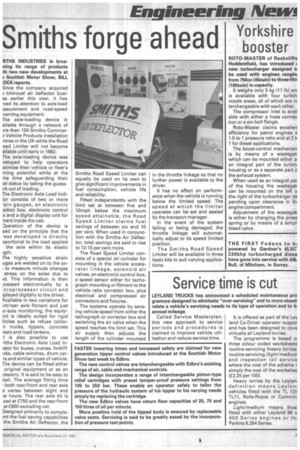flITHS INDUSTRIES is broaning its range of products th two new developments at a Scottish Motor Show, BILL :OCK reports.
Page 15

If you've noticed an error in this article please click here to report it so we can fix it.
since the company acquired a Uniroyal air deflector busi-. ss earlier this year, it has .ned its attention to axle-load aasurement and road-speed verning equipment.
The axle-loading device is ailable through a network of )re than 150 Smiths Commer1 Vehicle Products Installation ntres in the UK while the Road eed Limiter will not become ailable until early in 1982.
The axle-loading device was veloped to help operators rximise their vehicle or fleet's rning potential while at the Tre time safeguarding their ial status by taking the guessirk out of loading.
The Electronic Axle Load lnditor consists of two or more .airt gauges, an electronic iction box, electronic control x and a digital display unit for Tient inside the cab.
Dperation of the device is sed on the principle that the .ess developed is directly )portional to the load applied the axle within its elastic igth.
The highly sensitive strain uges are welded on to the ax; to measure minute changes stress on the axles due to rd. This information is then 3cessed electronically by a croprocessor circuit and ;played digitally to the driver. ekvailable in two variations for ,nt/rear axle fitment and just rr-axle monitoring, the equipant is ideally suited for rigid hides such as refuse colleen trucks, tippers, concrete xers and road tankers.
t is also possible to use iiths Electronic Axle Load Inator for buses, cranes, forklift Icks, cable winches, drum carrs and similar types of vehicle. The device can be fitted either original 'equipment or as an s'essory. It is said to be easy to ;tall. The average fitting time
• both rear/front and rear axle s varies between eight and le hours. The rear axle kit is ced at £750 and the rear/front at-£900 excluding vat.
Designed primarily to corn pieant the fuel saving capabilities the Smiths Air Deflector, the Smiths Road Speed Limiter can equally be used on its own to give significant improvements in fuel consumption, vehicle life and reliability.
Fitted independently with the limit set at between five and lOmph below the maximum speed attainable, the Road Speed Limiter claims fuel savings of between six and 10 per cent. When used in conjunction with the Smiths Air Deflector, total savings are said to rise to 12-15 per cent more.
The Road Speed Limiter consists of a special air cylinder for mounting in the vehicle accelerator linkage, solenoid air valves, an electronic control box, a speed sensor either for tachograph mounting or fitment to the vehicle ratio corrector box, plus electrical and compressed air connectors and fixtures.
The systems operate by sensing vehicle speed from either the tachograph or corrector box and switching the air valve when the speed reaches the limit set. This air supply than adjusts the length of the cylinder mounted in the throttle linkage so that no further power is available to the driver.
It has no effect on performance when the vehicle is running below the limited speed. The speed at which the limiter operates can be set and sealed by the transport manager.
In the event of the system failing or being damaged, the throttle linkage will automatically adjust to its speed limited position.
The Smiths Road Speed Limiter will be available in three basic kits to suit varying applications.


















































